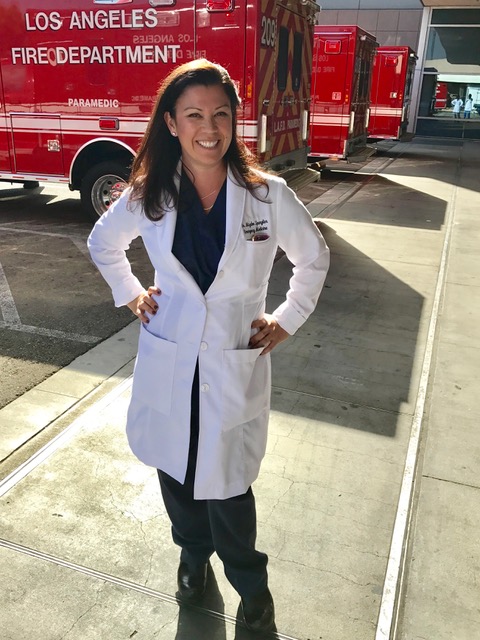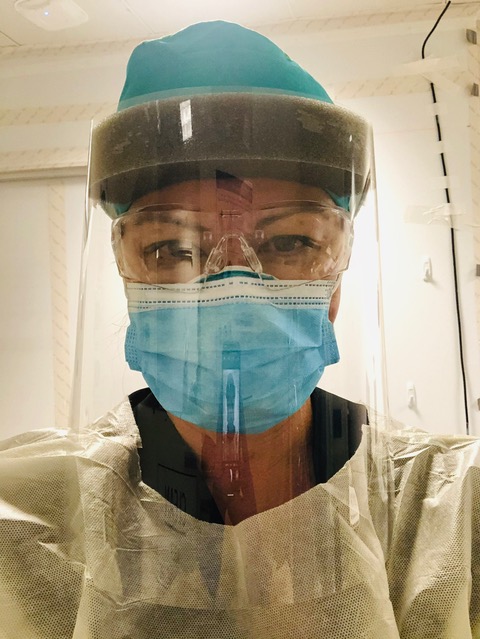Dear Montecito: Dr. Mizuho Morrison

I have this story I tell people to explain how I became interested in biology. It goes like this: When I was young, I watched Star Trek with my father. I liked to imagine myself zooming around, going to new planets, wearing my space-tech-fabric blue uniform (blue was, of course, my favorite color). There was only one problem: only the doctors and science officers got to wear blue. But I didn’t like medicine. Medicine was boring.
As our developing brains began to choose idols, my friends were seeking out superheroes, athletes, the like, while my thoughts started to change about medicine. Suddenly, I didn’t just admire scientists and the way they go around spouting chemical names and numbers with a lot of decimal places, but I wanted to be one too.
This week I’ve asked Dr. Mizuho Morrison to share her story with us. Please enjoy a letter from my newest idol and the daughter of the first Scottish person I ever met.
Dear Montecito,
You never quite realize how special a place is until you no longer get to call it home. Montecito is one of those places. I grew up in a somewhat unconventional way. My father was the groundskeeper at Montecito Union School for over 30 years. He was known for his thick Scottish brogue and rough exterior, but anyone who knows “Scottie” remembers a hard-working, dedicated man with a big heart. He was an icon in the Montecito community for the many generations of families that grew up there.
My parents immigrated to this country in the 1970s. My mother from Japan and my father from Glasgow did what any other hard-working immigrants do. They both worked tirelessly in hopes to provide my sister and I opportunities that they never had. My father took a lot of pride in his work. He never considered being the head custodian of MUS a simple day-job. Given the responsibility required that he physically live on the school grounds to oversee the school 24-7, meant that he literally lived, breathed, and ate there. And in turn, my sister and I got to grow up there.
The education that we received at MUS was arguably the best advantage they could have given us. As a young child, it gave me the sense that anything was possible. I think back fondly to my summers in Montecito. Like most kids in the late ‘80s, the time was spent unstructured. No summer camps, no electronics. Simply riding our bikes with friends to the Wine & Cheese shop, collecting tadpoles in the nearby creek and learning how to paint as I “helped” and worked alongside my dad with random odd end-jobs on campus. Living on campus also meant that the teachers, who are arguably the most committed group of folks I had ever seen, also spent much of their time there. And so I made myself useful babysitting their kids, while they worked on getting their classrooms together when their students were on break.
At age nine, I announced to my dad that “I want to be a doctor when I grow up!” He scoffed a bit, in a loving but honest way and replied: “You can do whatever you want. I just don’t think medicine is what you hope it is. It is far more political than you realize,” he told me. “But if this is what you want to do, do it… just make sure you give it 150 percent. Whatever you do, always give it 150 percent!” At the time, I didn’t really know what he was saying. Political? Aren’t you helping people? Decades later the irony of his comments would resonate.
Hard Work Pays Off
I knew fully well that despite my parents being some of the hardest working and most generous people I know, affording college was just not feasible. It would be up to me to figure it out. So, I immersed myself in competitive club swimming and other extracurricular activities. For many years, I remember my mother getting up at the crack of dawn, already dressed in her office attire ready to drive me to swim practice. I continued to swim for club, became the swim team captain at Santa Barbara High School, developed a love for public speaking and became ASB president. I was ecstatic when I was accepted into Cal Poly San Luis Obispo to study microbiology as a pre-med.

After undergrad, I sought a master’s degree at Boston University. Later, returning to California for medical school, I hoped to match into the “toughest” ER residency program I could get in to. Why? Because I wanted to feel like I could handle just about anything that came through the door. It was time to start at the USC Medical Center, dubbed the “knife and gun club.”
Residency was much like being immersed in a warzone. Quite literally. I wasn’t shocked to learn that the U.S. military rotates their medics through our ER to train before deploying them into combat overseas. So onward I went. Now married, 29 years old and eight months pregnant with my first child. It was a good thing I didn’t know any better at the time. I had no idea how grueling internship plus nursing and caring for a newborn post-night shift would be. Fast forward to my fourth year of residency, now equally pregnant with my second child as a senior resident running the trauma bay – it was a funny sight to say the least.
After training, I stayed on moonlighting as an attending at USC teaching residents but also enjoyed working in a community ER practice. With two young children as my primary focus, I felt emergency medicine was a pretty good “mom-job” due to the flexibility. However, the flipping of nights to days was wearing. And so, for self-sustainability purposes I felt it was important to expand my career. I had always been passionate about teaching, particularly bedside medicine, so now over ten years in I find myself with a wonderful “day-job” teaching other clinicians serving as senior director of medical education at Hippo Education while still working intermittent shifts in the ER on nights and weekends.
Fast forward to the spring of 2020, COVID-19 hits in Southern California. I suppose my early hunger to train in a specialty where I would be “ready for anything” is put to the test. At the time, we understood very little about the virus and even less about its virulence in hospital staff. Now, this was not my first pandemic. We had experienced H1N1 in 2009, cases of Ebola a few years later, but this… this felt different. There were characteristics of this virus and disease process that even our most senior physicians had never seen and left the scientific community perplexed. Add to that a national PPE shortage, and the combination was unnerving. Despite working for two of the largest medical systems in the country, we did not have enough protection. Our ER physician group all pitched in funds to buy PPE for our entire staff, as we could no longer rely on our administrations to provide the protection we needed, but this still wasn’t enough. We were literally reusing masks day after day. Something had to be done! So, in addition to drafting up my last will and testament, I also started crowdsourcing, hoping for donations of PPE. I sent emails to influencers, any connection I had on both coasts, and of course, back home to Montecito. Within two days, I got an email back from the CEO of Direct Relief International, Thomas Tighe. Apparently, he’d been forwarded my email from several Montecito connections asking, “Can you help her? She’s Scottie’s daughter.” Mr. Tighe not only offered to donate more than 2,000 N95 masks, but he personally drove the cases of masks down to me in L.A. His kindness and generosity and overall humanity was a perfect picture of the acts of kindness and strong sense of community that Montecito fosters.
Reflecting back, my earliest memories of Montecito remain true. It is a special community filled with incredible people. I am incredibly grateful to the people of the community I was raised in and to my parents who gave me the opportunity to grow up there. Particularly in a tough year where many of us are worn and strained in new, odd ways, it is important to reflect back on the things that matter most: family, friends, and a sense of community. Montecito beautifully embodies all of these things.
Be safe and well. May 2021 brings us all hope, health, and newfound happiness!
Dr. Mizuho Morrison
Twitter: @mizuhomorrison







You must be logged in to post a comment.